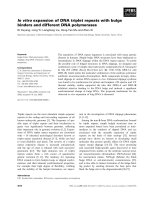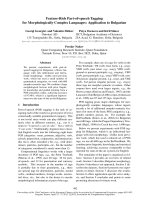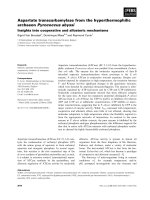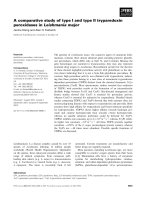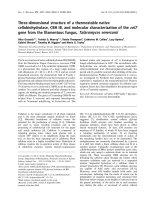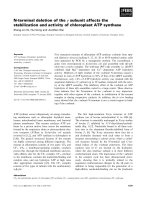Báo cáo khoa học: " Stereotactic, single-dose irradiation of stage I non-small cell lung cancer and lung metastases" docx
Bạn đang xem bản rút gọn của tài liệu. Xem và tải ngay bản đầy đủ của tài liệu tại đây (1.07 MB, 9 trang )
BioMed Central
Page 1 of 9
(page number not for citation purposes)
Radiation Oncology
Open Access
Research
Stereotactic, single-dose irradiation of stage I non-small cell lung
cancer and lung metastases
Peter Fritz*
1
, Hans-Jörg Kraus
1
, Werner Mühlnickel
1
, Udo Hammer
2
,
Wolfram Dölken
2
, Walburga Engel-Riedel
3
, Assad Chemaissani
3
and
Erich Stoelben
3
Address:
1
St. Marien-Krankenhaus, (Medical Education Hospital of the University of Marburg), Department of Radiotherapy, D-57072 Siegen,
Germany,
2
St. Marien-Krankenhaus, (Medical Education Hospital of the University of Marburg), Department of Radiology, D-57072 Siegen,
Germany and
3
Cologne Metropolitan General Hospital, Clinic for Thoracic Disease, D-51109 Köln, Germany
Email: Peter Fritz* - ; Hans-Jörg Kraus - ;
Werner Mühlnickel - w.mü; Udo Hammer - ;
Wolfram Dölken - w.dö; Walburga Engel-Riedel - ;
Assad Chemaissani - ; Erich Stoelben -
* Corresponding author
Abstract
Background: We prospectively reviewed response rates, local control, and side effects after non-
fractionated stereotactic high single-dose body radiation therapy for lung tumors.
Methods: Fifty-eight patients underwent radiosurgery involving single-dose irradiation. With 25
patients, 31 metastases in the lungs were irradiated; with each of 33 patients, stage I non-small cell
lung cancer (NSCLC) was subject to irradiation. The standard dose prescribed to the isocenter was
30 Gy with an axial safety margin of 10 mm and a longitudinal safety margin of 15 mm. The planning
target volume (PTV) was defined using three CT scans with reference to the phases of respiration
so that the movement span of the clinical target volume (CTV) was enclosed.
Results: The volume of the metastases (CTV) varied from 2.8 to 55.8 cm
3
(median: 6.0 cm
3
) and
the PTV varied from 12.2 to 184.0 cm
3
(median: 45.0 cm
3
). The metastases ranged from 0.7 to 4.5
cm in largest diameter. The volume of the bronchial carcinomas varied from 4.2 to 125.4
cm
3
(median: 17.5 cm
3
) and the PTV from 15.6 to 387.3 cm
3
(median: 99.8 cm
3
). The bronchial
carcinomas ranged from 1.7 to 10 cm in largest diameter. Follow-up periods varied from 6.8 to 63
months (median: 22 months for metastases and 18 months for NSCLC). Local control was achieved
with 94% of NSCLC and 87% of metastases. No serious symptomatic side effects were observed.
According to the Kaplan-Meier method the overall survival probability rates of patients with lung
metastases were as follows: 1 year: 97%, 2 years: 73%, 3 years: 42%, 4 years: 42%, 5 years: 42%
(median survival: 26 months); of those with NSCLC: 1 year: 83%, 2 years: 63%, 3 years: 53%, 4
years: 39%: (median survival: 20.4 months).
Conclusion: Non-fractionated single-dose irradiation of metastases in the lungs or of small,
peripheral bronchial carcinomas is an effective and safe form of local treatment and might become
a viable alternative to invasive techniques.
Published: 20 August 2006
Radiation Oncology 2006, 1:30 doi:10.1186/1748-717X-1-30
Received: 31 May 2006
Accepted: 20 August 2006
This article is available from: />© 2006 Fritz et al; licensee BioMed Central Ltd.
This is an Open Access article distributed under the terms of the Creative Commons Attribution License ( />),
which permits unrestricted use, distribution, and reproduction in any medium, provided the original work is properly cited.
Radiation Oncology 2006, 1:30 />Page 2 of 9
(page number not for citation purposes)
Background
Clinical practice since the 1980s and numerous publica-
tions have documented the indications and methodology
involved in and the results obtained from cranial stereo-
tactic irradiation techniques. The earliest reports on radia-
tion treatment of extracranial targets involving stereotactic
positioning are from Lax et al. [1] and Blomgren et al. [2],
who describe a "stereotactic body frame for exact tumor
localization and reproducible fixation", a frame devel-
oped at the Karolinska Hospital in Stockholm. In 1995
and in 1998, this Swedish research group published the
first clinical results of hypofractionated stereotactic radia-
tion treatment with high single doses. Major indications
were primary tumors of the liver and of the lungs and
metastases in the liver and lungs [1,2]. At the same time,
laser-induced thermotherapy (LITT) or high frequency-
induced thermotherapy (HITT) became attractive meth-
ods for local ablation of liver and lung tumors [3,4]. Find-
ings of the first studies of LITT and HITT treatments of
lung tumors have recently been published [5,6].
This paper reports on outcomes in 58 patients with metas-
tases in the lungs or with histologically confirmed, small,
peripheral, non-small-cell bronchial carcinomas, patients
who underwent stereotactic single-dose body radiation
therapy. At the date set for evaluation, all patients had
undergone follow-up observation for at least 6.0 months.
Methods
Eligibility
Eligible patients had no more than two targets and suffi-
cient pulmonary function (FEV 1 ≥ 1.0 l/s). Further criteria
had to be fulfilled: Karnofsky performance status ≥ 60%,
no proximity to high-risk organs, no signs of metastases in
other organs, primary tumor under control (in cases of
lung metastases). Histological confirmation was also
required. Patients with metastases from all primary
tumors were also included, with the exception of those
from SCLC or germ cell carcinomas. Additional criteria for
local radiation treatment of non-small-cell bronchial car-
cinomas (NSCLC) were as follows: peripheral site, no
signs of local lymph node metastases or of remote metas-
tases.
Radiation exposure to high-risk organs (trachea, esopha-
gus, great vessels, spinal cord and skin) had to be < 10 Gy.
At most, the planning target volume (PTV) (80% isodose)
could only be allowed to affect the wall of a hollow organ
along the length of the radiation field, but not any parts of
the lumen. Since a fibrosis of the skin was to be avoided
as far as possible, the distribution of the dose in the chest
wall was determined so that a maximum of 30% of the
isodose was allowed in the subcutis, i.e., 5 mm under the
skin. If these specifications could not be put into practice
with a corresponding treatment plan, the patient was
offered stereotactic hypofractionated treatment (not
described in detail in this paper). The proportion of
patients who were originally scheduled for single-dose
radiation therapy, but underwent hypofractionated radio-
therapy instead was 22%.
For all of the patients, there were either severe health con-
ditions or technical factors prohibiting conventional sur-
gery or chemotherapy, or the patients had refused surgery
or further attempts at chemotherapy. Stereotactic body
radiation therapy was approved by the regional ethics
committee and was in accordance with the Helsinki Dec-
laration, as revised in 1983. All patients were informed
about the experimental approach of this clinical trial and
gave their written consent.
Pretreatment assessment
All of the patients underwent a spirometric test (FEV 1),
CT scans of the thorax and abdomen, total body bone
scintigraphy, and laboratory examinations of blood count
and serum enzymes. Since differential diagnoses of the
coin-shaped density in the lungs can also include numer-
ous benign results from pneumonia to granulomas, histo-
logical confirmation of malignancy was required. All
occurrences of NSCLC and 55% of metastases were histo-
logically confirmed by bronchoscopy or CT-guided trans-
thoracic biopsy. All of the bronchial carcinomas and
metastases scheduled for stereotactic single-dose irradia-
tion were also subjected to flourodeoxyglucose positron
emission tomography (PET). For NSCLC, PET was used
primarily as a supportive, auxiliary examination method
to rule out local hilar or mediastinal metastases. Yet, a
hypermetabolism discovered in the PET was evaluated as
a lymph-node metastasis only if the CT scan showed top-
ographically correlated results. Classification of a coin-
shaped density in the lungs as a metastasis, then,
depended on the following criteria: known primary
tumor, manifestation and growth observed in earlier CT
scans, malign hypermetabolism exhibited in the PET scan,
or histological confirmation related to the primary tumor.
Defining the target volume and the radiation treatment
regimen
Before beginning with stereotactic single-dose radiation
treatment, the patient was positioned in the stereotactic
body frame using the abdominal compression device. At
first, a preliminary fluoroscopy was carried out. But even
with the use of the abdominal compression device, most
of the tumors exhibited noticeable respiratory motion. A
treatment-planning CT scan of the thorax with 3 mm slice
thickness was performed and displayed during 3 respira-
tory phases: normal inhalation, normal exhalation, and
the naturally contracted position of the chest. These series
of CT scans were then used to make an image fusion using
the Eclipse 3-D planning system (version 7.3.10; Varian).
Radiation Oncology 2006, 1:30 />Page 3 of 9
(page number not for citation purposes)
The identical position of the patients and the classifica-
tion of the slices through the localization markers in the
body frame facilitated a first-rate image fusion of the CT
scans. The clinical target volume (CTV) was determined
by the macroscopically visible gross tumor volume (GTV)
with the use of pulmonary windowing. For each set of CT
scans, the CTV was marked in separately. The superimpo-
sition of the various tumor positions, depending on the
respiratory phase, resulted in a presentation of the span of
the tumor's movement. The definitive planning target vol-
ume (PTV) was then marked in around this movement
span with a safety margin of 15 mm in the longitudinal
plane and 10 mm in the transverse plane so that all of the
active respiratory phases of the CTV were enclosed (Fig.
1).
The pencil beam algorithm of the Eclipse system was used
for dose calculation and for 3-D treatment planning. The
inhomogeneity correction was computed with the modi-
fied Batho power law, as implemented in Eclipse. The
dose was prescribed to the isocenter. Five to eight copla-
nar, conformal fields were planned and were then irradi-
ated, using a linear accelerator (Precise SLi, Elekta) with a
multileaf collimator (leaf width: 10 mm).
The standard dose prescribed to the isocenter was 30 Gy.
The definition of the target volume ensured that, of the
prescribed isocenter dose, at least 90% covered the gross
tumor volume (GTV = CTV) and at least 80% the PTV (Fig.
2). Irradiation was performed 3 to 4 days after the CT scan
for treatment planning. Prior to irradiation, a second
series of CT scans was performed in order to ensure the
reproducibility of the patient's position and the position
of the previously planned isocenter over the entire target.
The slices displaying the isocenter and the target were
compared with the CT treatment plan. All prominent ana-
tomical structures were used for this comparison (pulmo-
nary vessels, airways, bony structures, and the tumor
image). Additionally, the patient's position in x and y
directions, i.e., with reference to the bottom panel and to
the side panels of the stereotactic frame, was measured
using a distance cursor and compared to the specifications
from the planning CT scan in order to rule out or correct
changes in the patient's vertical and lateral position in the
vacuum pillow. After this procedure, the patient was
transported in the body frame to the linear accelerator.
Here, a third check on the isocenter was carried out by
comparing portal images (Iview system, Elekta) with vir-
tually simulated images. Compared to the treatment plan,
in all cases corrections of the isocenter coordinates in the
longitudinal or transverse plane were less than 5 mm.
planning target volume (red line ) and dose distribution for
single-dose irradiation of a bronchial carcinoma using six
coplanar portals (course of remission see figures 3a, b, c)
Figure 2
planning target volume (red line ) and dose distribution
for single-dose irradiation of a bronchial carcinoma using six
coplanar portals (course of remission see figures figures 3a,
b, c, d).
Å
Image fusion of three dynamic CT scans in a reconstructed sagittal plane for determining target position (CTV) during respirationFigure 1
Image fusion of three dynamic CT scans in a reconstructed
sagittal plane for determining target position (CTV) during
respiration. (Green line: normal inhalation, pink line: naturally
contracted position of the chest, blue line: normal exhalation,
red line: PTV.) Tilting the tumor in x and y axes during respi-
ration facilitates the phase-specific display of the CTVs.
Radiation Oncology 2006, 1:30 />Page 4 of 9
(page number not for citation purposes)
Follow-up
All of the patients were checked using high-resolution hel-
ical CT scans of the entire lung at 6 and 12 weeks after the
single-dose radiation treatment. Standard slice thickness
was 8 mm to minimize the radiation exposure of the
entire thorax, as there were frequent follow-up CT exami-
nations. If suspect alterations occurred, additional CT
scans with 3 mm slices were made so that a comparison
with the high-resolution treatment-planning CT as a refer-
ence CT for follow-up was provided. Further follow-up
examinations then took place in three-month intervals. In
accordance with WHO criteria, tumor response was
defined as complete if all abnormalities that were ana-
tomically related to the tumor disappeared after treat-
ment, and defined as partial if the maximum size of these
abnormalities decreased by ≥ 50%. CT images were inde-
pendently interpreted by three diagnostic radiologists. CT
characteristics were determined on the basis of a consen-
sus among at least two of the three radiologists. Respira-
tory functions (FEV 1) were measured in six-month
intervals.
Statistics
Statistical endpoints were overall survival and freedom
from local failure according to the Kaplan-Meier method.
Medcalc version 8.2.1.0, Schoonjans, was used for statisti-
cal analysis. Additionally, the initial response six months
after radiotherapy was measured by volumetric analysis
based on CT slices using the planning system Eclipse
7.3.10 (Varian).
Results
Patient collective
The follow-up period was defined as the time between
irradiation and the last follow-up examination including
a thoracic CT scan. The median follow-up period for
patients with lung metastases was 22 months (periods
extending from 6.8 to 63 months) and for patients with
NSCLC 18 months (extending from 7.7 to 53.4 months).
The median age for patients with lung metastases was 65
years (range: 32 – 82 years) and 72 years for patients with
NSCLC (range: 59 – 82 years). Forty men and 18 women
were treated. With reference to the origin of the metas-
tases, data were as follows: 9 targets were metastases from
rectal cancer, non-small cell lung carcinoma (n = 10),
breast cancer (n = 6), ENT (n = 3), other origin (n = 3).
Biopsies of bronchial carcinomas exhibited the following
histological results: squamous cell carcinoma n = 15, ade-
nocarcinoma n = 11, large cell carcinoma n = 5, NOS (not
otherwise specified) n = 2. For all of the patients, there was
no significant temporal relationship to previous chemo-
therapy. None of the patients underwent concurrent
chemotherapy.
Target volumes
The volume of the metastases (CTV) varied from 2.8 to
55.8 cm
3
(median: 6.0) and the PTV varied from 12.2 to
184.0 cm
3
(median: 45.0). The metastases ranged from
0.7 to 4.5 cm in largest diameter (median: 2.5 cm). In 6
patients, 2 lung sites were irradiated concurrently. The
volume of the bronchial carcinomas varied from 4.2 to
125.4 cm
3
(median: 17.5) and the PTV from 15.6 to 387.3
cm
3
(median: 99.8). The bronchial carcinomas ranged
from 1.7 to 10 cm in largest diameter (median: 5.5 cm).
Control rates and survival
Since the regression of tumors, especially of larger ones,
sometimes proceeds at a slow rate, the degree of initial
remission was assessed 6 months after single-dose radia-
tion treatment had occurred. Fifty-eight of sixty-four
(90.6%) tumors responded to therapy (Fig. 3a,b,c,d). The
extent of tumor response was difficult to measure in some
cases due to the appearance of radiation-induced intersti-
tial changes. The majority of these postradiation changes
began at the site of the 30–40% isodose area. So in most
cases, residual tumors could be distinguished from char-
acteristics of radiation pneumonitis. On the other hand,
we considered any suspect residual irregular density to be
evidence of residual tumor tissue (partial remission). The
actual complete remission rate, then, may be higher. In 17
out of 33 (51.5 %) patients with NSCLC, solid tumor for-
mations completely disappeared and were classified as
complete remission (CR). Fourteen patients (42.4 %)
exhibited a partial remission (PR) and two NSCLC
relapsed (6.0 %). Twenty out of 31 metastases showed a
CR (64.5 %), 7/31 a PR (22.6%) and four metastases
relapsed (12.9%) during further follow-up. In further fol-
low-up after high-dose radiosurgery, distinguishing
between tumor recurrence and radiation pneumonitis
and fibrosis proved to be difficult.
Tumor progression or recurrence was assumed if a pro-
gressive increase of solidification within the planning tar-
get volume (PTV) could be observed between successive
CT scans during a follow-up period of six months. The
patients involved also had a PET scan performed. If the
scan showed a hypermetabolism typical of tumors, a fur-
ther biopsy or salvage operation was carried out. This sit-
uation occurred in five patients after radiotherapy (two
cases of NSCLC and three of lung metastases), and, in all
cases, the radiological and nuclear-medicine diagnosis
was confirmed histopathologically.
On the date set for evaluation (March 31, 2006) or at the
time of death, 21 patients with irradiated lung metastases
and 24 patients with NSCLC had undergone a follow-up
period > 12 months. Thirty-one of 33 NSCLC (94%) and
27 of 31 metastases (87%) manifested local control. Rela-
tive to the number of lesions irradiated, the probability of
Radiation Oncology 2006, 1:30 />Page 5 of 9
(page number not for citation purposes)
a, b, c, d: (a) bronchial carcinoma before single-dose irradiation with 30 Gy, (b) partial remission after 10 months, (c) complete remission 21 months after irradiation leaving a scarlike fibrosisFigure 3
a, b, c, d: (a) bronchial carcinoma before single-dose irradiation with 30 Gy, (b) partial remission after 10 months, (c) complete
remission 21 months after irradiation leaving a scarlike fibrosis. (d) dense consolidation after 48 months.
Radiation Oncology 2006, 1:30 />Page 6 of 9
(page number not for citation purposes)
local control reached 80% at 5 years for metastases and
83% at 4 years for NSCLC (Fig. 4). The probability of over-
all survival for patients with metastases calculated accord-
ing to Kaplan-Meier was as follows: one year: 97%, 2
years: 73%, 3 years: 42%, 4 years: 42%, 5 years: 42%
(median survival 26 months); for patients with NSCLC:
one year: 83%, 2 years: 63%, 3 years: 53%, 4 years: 39%
(median survival 20.4 months) (Fig. 5). The most signifi-
cant cause of death for the patients who died was systemic
progression with occurrences of new metastases. At
present, no significant difference in terms of local control
and overall survival has been detected in comparing
patients after irradiation of lung metastases or of primary
lung cancer (log rank test).
Side effects
The median volume encompassed by the 9 Gy isodose
was 9.1% of total lung volume (range: 2.2 to 23.1%). The
12 Gy and 15 Gy isodose encompassed 7.0% (range: 1.6
to 16.4 %) and 5.3% (range: 1.2 to 14.3%), respectively.
Yet, these volumes and the planning target volumes were
still small in comparison to the total volume of the lungs
and, up to this point, have resulted neither subjectively
nor objectively in a diminution of respiratory functions.
No patient died due to respiratory insufficiency (Fig. 6).
Except for four cases of acute grade 1 radiation dermatitis
(WHO- Toxicity Criteria) following radiation treatment of
tumors situated near the thoracic wall, there were no
symptomatic side effects. In particular, no patient had to
be treated because of pneumonitis. At the time of
response evaluation (six months after irradiation), 73% of
our patients exhibited characteristics of radiation pneu-
monitis on the CT scans.
In 8 of 33 patients with NSCLC (24 %), CT scans revealed
pneumonitic alterations in sites near the thorax wall asso-
ciated with asymptomatic, cytologically benign, tempo-
rary pleural effusions, which, in contrast to malignant
pleural effusions, were only of slight volume and disap-
peared after several months without treatment.
Respiratory functions (FEV 1) after stereotactic single-dose
irradiation (●metastases, bronchial carcinomas, median and
range values for patients (n) alive and available at the speci-
fied follow-up periods)
Figure 6
Respiratory functions (FEV 1) after stereotactic single-dose
irradiation (●metastases, bronchial carcinomas, median
and range values for patients (n) alive and available at the
specified follow-up periods).
5 10152024
months
22
28
FEV 1
[l/sec.]
0.5
1.0
1.5
2.0
0
¦
¦
¦
¦
2.0 (1.1-3.0
)
1.9 (0.9-2.7) 2.0 (1.0-2.7) 2.1 (1.0-2.7)
ÁÁ
Á
Á
Á
1.5 (1.0-2.9) 1.5 (0.9-3.0) 1.6 (0.7-2.7) 1.5 (1.1-2.2)
1.4 (1.0-2.1) Á
25
33
16
19
8
10
7
6
n= ¦
n= Á
2.5
¦
1.7 (0.9-2.3) ¦
Æ
probability of local control (FFLF = freedom from local fail-
ure): metastases, NSCLC
Figure 4
probability of local control (FFLF = freedom from local fail-
ure): metastases, NSCLC
__
_
probability of overall survival : metastases, NSCLC
Figure 5
probability of overall survival : metastases,
NSCLC.
___
Radiation Oncology 2006, 1:30 />Page 7 of 9
(page number not for citation purposes)
Discussion
A number of studies on stereotactic body radiation ther-
apy of lung tumors have been published. Several research
teams that carried out hypofractionated, stereotactic irra-
diation, applied 3 to 10 fractions with doses per fraction
varying from 6 to 20 Gy [7-10,12]. The cumulative refer-
ential doses of the hypofractionated series totaled 24 to 60
Gy. Moreover, doses were specified in widely divergent
ways: prescribed to 65% isodose volume [2,11], to 80%
isodose [10,12,13], or to the isocenter [9].
Some of the patients of Nakagawa et al. [8] and of
Uematsu et al. [13] received conventionally fractionated
radiation treatment, so that the 'stereotactic irradiation'
only functioned as a 'boost'. It is difficult to compare all
of these courses of treatment. Yet, the fractionated series
all involve higher single doses irradiated under precise
stereotactic conditions. The consistency of the results with
high local control rates of 80–100% and with a very slight
incidence of symptomatic side effects is especially note-
worthy.
Non-fractionated single-dose irradiation is more conven-
ient for the patient but the literature on the clinical expe-
rience of this approach is scanty. Results of single-dose
irradiation of lung tumors have been published by Hara et
al. [14] and Hof et al. [15] – studies involving patient col-
lectives of 19 and 10 patients and mean follow-up periods
of 13 and 14.9 months, respectively. Hof et al. [15] irradi-
ated 10 histologically confirmed non-small-cell bronchial
carcinomas < 5 cm with doses prescribed to the isocenter
ranging from 19 to 26 Gy. Under respiratory gating, Hara
et al. [14] irradiated 23 lung metastases or bronchial car-
cinomas < 4 cm with doses of 20 to 30 Gy specified to the
edge of the tumor (GTV = CTV). Single-dose irradiation
was also tested by Wulf et al. [16] as an alternative to
hypofractionated sterotactic body radiation therapy for
primary lung cancer and pulmonary metastases. Twenty-
five metastases (and one NSCLC) were irradiated with 26
Gy prescribed to the 80%-isodose comprising the PTV,
which corresponds to approximately 31.5 Gy at the iso-
center (PTV = CTV plus 5 mm margins). During the fol-
low-up (median: 9 months), no local failure was
observed. Thus, our dosage was in accordance with the
magnitude of reference doses reported by these authors.
Our results correspond to those of Hara et al., Hof et al.,
and Wulf et al., who were also able to attain high local
control rates ranging from 80 to 100%, with no serious
symptomatic side effects. The post-radiation treatment
changes in lung parenchymas shown in CT scans seem to
exhibit a decelerated dynamics, different from that of the
changes following conventionally fractionated radiation
treatment. Unlike changes associated with conventional
radiation therapy, the pulmonary opacities did not pre-
cisely correspond to the planned target volume, were
often located at the periphery of the dose distribution,
and could undergo change in shape and location for
months. No pleural effusions were found after single-dose
radiation treatment of lung metastases, which is probably
related to the much smaller volumes of irradiation.
Two NSCLC and four metastases relapsed. The CTV of the
metastases were 2.8 cm
3
, 6.5 cm
3
, 12.6 cm
3
and 32 cm
3
.
Three of them were metastases from a rectal carcinoma
(adenocarcinoma) and one from an adenoidcystic carci-
noma. The CTV for the NSCLC that relapsed were 55
cm
3
(large cell carcinoma) and 32 cm
3
(squamous cell car-
cinoma). At present, as the number of relapses is small, we
cannot see any patterns of recurrences in terms of target
histology and CTV.
Introducing respiratory gating indicates problems of accu-
racy with respect to targets involving respiratory motion.
Also, the time expenditure needed for respiratory gating
can, in itself, prove to be an obstacle: Hara et al. specify
this as one hour. Other authors used the abdominal com-
pression device of the stereotactic body frame. Wulf et al.
[17] investigated the "impact of target reproducibility on
tumor dose in stereotactic radiotherapy of targets in the
lung and liver" and found that "pulmonary targets with
increased breathing mobility are at risk for target devia-
tion exceeding the standard security margins for PTV-def-
inition and require individual evaluation of sufficient
margins." Hof et al. [18] concluded: "In our experience,
the abdominal compression device integrated into the
stereotactic frame limits diaphragmatic movement only
inadequately." Our observations of widely divergent indi-
vidual respiratory motion despite using the abdominal
compression device correspond to these studies and con-
firm our original concept of defining the target volume
with reference to the phases of respiration. Precisely for
single-dose irradiation, 100% target coverage (TC) is of
extreme importance because the target has to be eradi-
cated with "one shot", and "quiet respiration" cannot be
guaranteed. For this reason, we did not adopt the PTV
specified by Blomgen and Lax et al. [1,2]. Another method
for solving the problem of respiratory motion, adminis-
tering high-frequency jet ventilation (HFJV) under general
anesthesia, has proven effective for the total immobiliza-
tion of targets in the liver [19] and is now being tested for
SBRT of lung tumors.
Local irradiation alone for stage I NSCLC is a controversial
issue. Several publications describe only a low risk for
regional lymph-node relapse after careful staging [20-23].
In the light of the average age and the health conditions of
our patient collective, we decided to dispense with medi-
astinal irradiation. No regional lymph-node relapses have
been observed thus far.
Radiation Oncology 2006, 1:30 />Page 8 of 9
(page number not for citation purposes)
Biologically equivalent doses (BED) can be calculated
with the use of linear quadratic modeling, but this tech-
nique itself was derived from experiments with fractiona-
tion that were conducted in vitro or in vivo. In a recent
article, Fowler et al. [24] attempted to develop a radiobio-
logical model for hypofractionated high, single doses like
those used in stereotactic body radiation therapy. But
Fowler also clearly states that "linear quadratic (LQ) mod-
elling is employed with only the standard assumption
that LQ-modelling is valid up to 23 Gy per fraction."
Fowler concedes that "ongoing clinical trials from an
increasing number of centers will be reporting the results
of tumor control and complications from this new modal-
ity of biologically higher doses." These statements from an
authoritative radiobiologist demonstrate that this is new
ground which has yet to be empirically evaluated. For this
reason, we prefer to refrain from speculating on the radi-
obiological efficacy of our single-dose irradiation in com-
parison to hypofractionated stereotaxis schemes.
Conclusion
Stereotactic single-dose irradiation could become an effec-
tive, non-invasive alternative to conventional surgery on
metastases in the lungs. This alternative treatment
involves few side effects but about 90% local control rates.
Possible further indications might include the eradication
of peripheral stage I non-small cell lung cancer. We have
demonstrated the efficacy, feasibility, and safety of this
approach in medically inoperable patients. Further explo-
ration of the approach is warranted.
Competing interests
The author(s) declare that they have no competing inter-
ests.
Authors' contributions
PF and H-J K: were responsible for conception, design and
clinical treatment.
WM: performed the statistical analysis and was clinically
responsible for treatment planning and dose calculation.
UH and WD: were the main diagnostic radiologists who
analyzed the CT scans during follow-up.
W E-R, AC and ES: cared for the patients as lung specialists
and were responsible for measuring the respiratory func-
tions during follow-up.
References
1. Lax I, Blomgren H, Larson D, Näslund I: Extracranial stereotactic
radiosurgery of localized targets. J Radiosurgery 1998, 1:135-148.
2. Blomgren H, Lax I, Näslund I, Svanström R: Stereotactic high dose
fraction radiation therapy of extracranial tumors using an
accelerator. Clinical experience of the first thirty-one
patiens. Acta Oncol 1995, 34:861-870.
3. Vogl TJ, Mack MG, Roggan A, Straub R, Eichler KC, Müller PK, Knappe
RV, Felix R: Internally cooled Power laser for MR-guided inter-
stitial laser-induced thermotherapy of liver lesions: Initial
clinical results. Radiology 1998, 209:381-385.
4. Vogl TJ, Straub R, Eichler K, Woitaschek D, Mack MG: Malignant
liver tumors treated with MR imaging-guided laser-induced
thermotherapy. Experience with complications in 899
patients (2,520 lesions). Radiology 2002, 225:367-377.
5. Hosten N, Stier A, Weigel C, Kirsch M, Puls R, Nerger U, Jahn D,
Stroszczynski C, Heidecke CD, Speck U: Laser-Induced Thermo-
therapy (LITT) of Lung Metastases: Description of a Minia-
turized Applicator, and Initial Treatment of Patients. Fortschr
Röntgenstr 2003, 175:393-400.
6. Suh R, Reckamp K, Zeidler M, Cameron R: Radiofrequency abla-
tion in lung cancer: promising results in safety and efficacy.
Oncology (Williston Park) 2005, 19(11 Suppl 4):12-21.
7. Onishi H, Kuriyama K, Tanaka S, Sano N, Marino K, Ikenaga S, Araki
T, Uematsu M: Clinical outcomes of stereotactic radiotherapy
for stage I non-small cell lung cancer using a novel irradiation
technique: patient self-controlled breath-hold and beam
switching using a combination of linear accelerator and CT
scanner. Lung Cancer 2004, 45:45-55.
8. Nakagawa K, Aoki Y, Tago M, Terahara A, Ohtomo K: Megavoltage
CT-assisted stereotactic radiosurgery for thoracic tumors:
Original research in the treatment of thoracic neoplasms. Int
J Radiat Oncol Biol Phys 2000, 48:449-457.
9. Nagata Y, Negoro Y, Aoki T, Mizowaki T, Takayama K, Kokubo M,
Araki N, Mitsumori M, et al.: Clinical outcomes of 3D conformal
hypofractionated single high-dose radiotherapy for one or
two lung tumors using a stereotactic body frame. Int J Radiat
Oncol Biol Phys 2002, 52:1041-46.
10. Timmerman R, Papiez L, McGarry R, Likes L, DesRosiers C, Frost S,
Williams M: Extracranial stereotactic Radioablation. Results
of a phase I study in medically inoperable stage I non-small
cell lung Cancer. Chest 2003, 124:1946-1955.
11. Lee S, Choi EK, Park HJ, Ahn SD, Kim JH, Kim KJ, Yoon SM, Kim YS,
Yi BY: Stereotactic body frame based fractionated radiosur-
gery on consecutive days for primary of metastatic tumors
in the lung. Lung Cancer 2003, 40:309-315.
12. Wulf J, Hädinger U, Oppitz U, Thiele W, Ness-Dourdoumas R, Flentje
M: Stereotactic radiotherapy of targets in the lung and liver.
Strahlenther Onkol 2001, 177:645-655.
13. Uematsu M, Shioda A, Suda A, Fukui T, Ozeki Y, Hama Y, Wong JR,
Kusano S: Computed tomography-guided frameless stereo-
tactic radiotherapy for stage I non-small-cell lung cancer: A
5-year experience. Int J Radiat Oncol Biol Phys 2001, 51:666-670.
14. Hara R, Itami J, Kondo T, Aruga T, Abe Y, Ito M, Fuse M, Shinohara
D, Nagaoka T, Kobiki T: Stereotactic single high dose irradia-
tion of lung tumors under respiratory gating. Radiotherapy and
Oncology 2002, 63:159-163.
15. Hof H, Herfarth KK, Münter M, Hoess A, Motsch J, Wannenmacher
M, Debus J: Stereotactic single-dose radiotherapy of stage I
non-small-cell lung cancer (NSCLC). Int J Radiat Oncol Biol Phys
2003, 56:335-341.
16. Wulf J, Haedinger U, Oppitz U, Thiele W, Mueller G, Flentje M: Ster-
eotactic radiotherapy for primary lung cancer and pulmo-
nary metastases: a noninvaxive treatment approach in
medically inoperable patients. Int J Radiat Oncol Biol Phys 2004,
60:186-196.
17. Wulf J, Hädinger U, Oppitz U, Thiele W, Flentje M: Impact of target
reproducibility on tumor dose in stereotactic radiotherapy
of targets in the lung and liver. Radiother Oncol 2003, 66:141-150.
18. Hof H, Herfarth KK, Münter M, Essig M, Wannenmacher M, Debus J:
The Use of the multislice CT for determination of respira-
tory lung tumor movement in stereotactic single-dose irra-
diation. Strahlenther Onkol 2002, 8:542-547.
19. Fritz P, Kraus HJ, Dölken W, Mühlnickel W, Müller-Nolte F, Hering
W: Gold Marker Implants and High-Frequency Jet Ventila-
tion for Stereotactic, Single-Dose Irradiation of Liver
Tumors. Technology in Cancer Research & Treatment 2006, 5:9-14.
20. Cheung PCF, Mackillop WJ, Dixon P, Brundage MD, Youssef YM,
Zhou S: Involved-field radiotherapy alone for early-stage non-
small-cell lung cancer. Int J Radiat Oncol Biol Phys 2000,
48:703-710.
21. Hayakawa K, Mitsuhashi N, Furuta M, Saito Y, Nakayama Y, Katano S,
Yamakawa M, Hashida I, Niibe H: High-dose radiation therapy for
Publish with Bio Med Central and every
scientist can read your work free of charge
"BioMed Central will be the most significant development for
disseminating the results of biomedical research in our lifetime."
Sir Paul Nurse, Cancer Research UK
Your research papers will be:
available free of charge to the entire biomedical community
peer reviewed and published immediately upon acceptance
cited in PubMed and archived on PubMed Central
yours — you keep the copyright
Submit your manuscript here:
/>BioMedcentral
Radiation Oncology 2006, 1:30 />Page 9 of 9
(page number not for citation purposes)
inoperable non-small cell lung cancer without mediastinal
involvement (clinical stage N0, N1). Strahlenther Onkol 1996,
172:489-495.
22. Hayakawa K, Mitsuhashi N, Saito Y, et al.: Limited field irradiation
for medically inoperable patients with peripheral stage I
non-small cell lung cancer. Lung Cancer 1999, 26:137-142.
23. Slotman BJ, Antonisse IE, Njo KH: Limited field irradiation in
early stage (T1-2N0) non-small cell lung cancer. Radiother
Oncol 1996, 41:41-44.
24. Fowler JF, Tomé WA, Fenwick JD, Mehta MP: A challenge to tra-
ditional radiation oncology. Int J Radiat Oncol Biol Phys 2004,
60:1241-1256.




